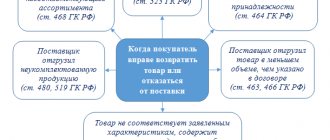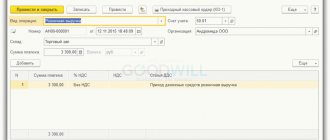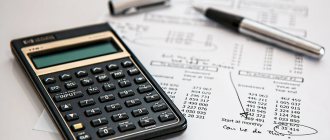What is the fundamental difference?
The difference lies in the method of recording income and expenses for the selected accounting period. Those. in which business transactions for the period are considered expenses and which are income. It is clear that during the entire existence of the enterprise, all receipts of money are income, and all payments are expenses. But we are not interested in the entire working time, but in each specific period. Quarter, month, week or even day. When we divide our time line into segments, the difference arises.
Under the cash method, income is considered to be any receipt of funds in the cash register or to a current account, and expenses are any payment or disbursement made during the accounting period. In this case, the relationship between income and expenses for the same period does not matter. We bought vodka, sold an hour of karaoke - it’s still income and expense.
Under the accrual method, income for a period is considered to be the sales value of goods sold and services provided in this period, regardless of their payment. And an expense is considered to be the cost of goods and services sold, as well as the enterprise’s consumption of goods and services, and also regardless of their payment to the supplier. Those. if Borscht is income, then everything related to this Borscht is considered an expense - food, cook’s salary, hall rent, electricity, etc. Those. everything that led to the opportunity to realize this particular Borscht.
Determining the planned amount of revenue using the shipping method and the cash method
When planning shipment revenue, only finished products in the warehouse at the beginning and end of the planned period are considered unsold. The amount of revenue from sales of products using the shipment method in planned financial calculations can be determined using the following formula:
Vpl = Tpl + O1 + O2,
where Vpl is the planned value of sales revenue;
Tpl - the value of the forecasted output of marketable products in the planning period;
O1 - change in the balances of finished products in the warehouse at the end of the planning period compared to the beginning in selling prices;
O2 - change in the balances of goods shipped at the end of the planning period compared to the beginning in selling prices.
If we consider the cash method of revenue planning, the expected balances of unsold products at the beginning of the planning period consist of:
- finished products in warehouse;
- goods shipped for which payment was not due;
- goods shipped but not paid for on time by buyers;
- goods held in safe custody by buyers.
The balance of unsold products at the end of the planning period takes into account:
- finished products in warehouse;
- shipped goods for which payment is not due.
When planning balances of finished products at the beginning of the planning period, the enterprise does not have comprehensive data on the actual amount of balances, therefore, the expected balances of unsold products are taken into account.
The cost of balances is calculated using a conversion factor, which is the quotient of dividing the volume of production in prices of the reporting period by the production cost of production for this period.
Please note
Sales prices in the planning period are determined based on the prices of the base period, which are adjusted for expected changes in the planning period, including taking into account supply and demand.
Which method is better?
It depends on situation.
The cash method is easier to implement because... is based on data from payment systems, which is very easy to collect - they are reflected in the cash register or banking system and are always confirmed by primary documents. In addition, the result of this method - profit - coincides with the cash balance, i.e. can be easily verified (by cash count).
The accrual method is more complicated, and its profit does not coincide with the cash balance, but it is more accurate in the sense that if the profitability or efficiency of the enterprise is calculated by the profit received, then it makes more sense, because income, expense and profit are interrelated.
The difference between them can be illustrated by the example of gasoline consumption in a car. Gas mileage is something we use to measure the “efficiency” of a car (and driving style). The lower the gas mileage, the better.
The “accrual method” is when we compare the distance traveled during a period with the volume of gasoline consumed during the same period. For this we use the on-board computer. We can drive 100 km in one week and spend 7 liters (7 l/100km), and drive 1000 km in another week and spend 60 liters (6 l/100km). Obviously, in the second week we drove more economically or “more efficiently”.
The “cash method” is when we compare the distance traveled during a period with the volume of gasoline purchased (filled in the tank) during the same period. We can fill 50 liters in one week and drive 1 km (5000 l/100km), and the next week add another 1 liter and drive 100 km (1 l/100km). Obviously, the results are not comparable, they make no sense.
Direct counting method
This method is based on guaranteed demand .
It is based on the fact that the entire volume of manufactured products is calculated on a pre-issued package of orders for the upcoming financial year (based on contracts and requests from customers). This method of revenue planning is the most reliable , since the production plan and sales volume are linked in advance to consumer demand, the required assortment and production structure are known, and appropriate prices are set. Here, the level of development of the product range by type, brand, grade, coordination with customers of their volume and prices for the planned period is of great importance.
The essence of the method : for each type of product, the volume of sales is calculated in selling prices, and then the results are added up. In this case, sales revenue ( B ) can be determined using the following formula:
B = P x C,
where P is the volume of comparable products sold;
P is the price of a unit of products sold.
Calculation method
The calculation method is used in conditions of uncertainty of demand for the products produced by the enterprise. The basis of the method is the volume of products sold, adjusted for input and output balances.
When using the calculation method, the planned amount of sales revenue is determined based on the amount of expected balances of unsold products at the beginning and end of the planning period, as well as from the amount of the forecasted output of marketable products in the planning period.
Since in a given period the produced marketable products are not fully sold, when planning sales revenue, the volumes of carryover balances at the beginning and end of the planning period are taken into account, as a result of which the planned sales volume is determined using the following formula:
Vpl = He + TP – Ok,
where Vpl is the planned revenue from product sales;
It is the carryover balance at the beginning of the period;
TP - commercial products;
Ok - carryover balances at the end of the period.
Let's calculate the revenue from product sales (Table 1).
An important point: the calculation of the planned revenue depends on the method of its accounting.
When should you use the cash method?
The cash method, however, is not simply “simple but meaningless.” There are situations when it can and should be used.
1. If your income and expenses for the period are in no way related to each other. One example I can give: software development and sales. Licenses sold over the past month are not directly related to programmers' salaries. And in this sense, the moment of transferring the rights to the license to the client is no different from the moment of payment for this license. Therefore, it is difficult to calculate the “effectiveness” of a development company as a whole.
2. If at the boundaries of periods the size of inventories and debts remains constant. In particular, zero. Those. if by the end of the period you don’t owe anyone (zero “creditor”), no one owes you (zero “debtor”) and you have no inventory, then you can safely count your profit on the cash basis. The result will be the same as with the accrual method, only it’s easier to calculate. I repeat once again - the amounts of inventories and debts are zero or the same as at the beginning of the period.
Even according to Russian legislation for small businesses - i.e. for those whose annual turnover does not exceed 1 million rubles, it is allowed to record profits using the cash method. This is done because it is believed that for such enterprises the change in inventories and debts from period to period is insignificant. And they can be neglected in the calculation.
Accounting for expenses using the cash method
The fact of payment is a key event in the cash method. Payment within the framework of recognition of expenses means the termination of a counter-obligation to the seller. The outflow of funds must necessarily be associated with goods, works or services purchased by the company.
When recognizing certain types of expenses, there are additional conditions. For example, for companies on OSNO, the costs of materials and raw materials can be taken into account only as they are sent to production. Depreciation can be taken into account only if the depreciable property is paid for and used in production. For simplified organizations, there is a restriction on accounting for expenses on goods for resale: such expenses are written off as products are sold.
When can an advance paid by a company to a counterparty be taken into account in expenses? Even if the company operates on a cash basis, such a payment cannot be recognized as an expense. Thus, in practice, prepayments to suppliers are recorded at the time of shipment of goods or provision of services/work.
When should you use the accrual method?
Well, actually, the same two points, only in reverse.
1. If you have a clear relationship between income and expenses.
2. If you have accounts receivable and/or payable and they are constantly changing. And also if you have warehouse stocks and their volume at the boundaries of periods is also unstable.
In these cases, it makes sense to use the accrual method because:
1. The ratio of related income and expenses can show you the performance of your business for any given period. And they can and should be compared.
2. The error introduced by debts and changes in inventories is too large and has a significant impact on the result.
We adjust revenue taking into account changes in the production plan
The enterprise's cost of marketable products in 2021 at selling prices amounted to 9,350 thousand rubles, the production cost of these products for the year was 8,130 thousand rubles. A preliminary calculation of planned revenue for 2021 is presented in table. 2.
Let's calculate the planned volume of revenue from sales in the selling prices of the enterprise.
1. To determine the cost of finished product balances in the planned year, we will find the conversion factor . To do this, divide the volume of production by its cost:
9350 thousand rub. / 8130 thousand rub. = 1,15.
2. Let’s calculate the cost of finished product balances at selling prices in the planning year:
480 thousand rubles. x 1.15 = 552 thousand . rub .
3. In 2021, the production of commercial products at selling prices is provided in the amount of 9,360 thousand rubles. It follows that its one-day release will be:
9360 thousand rubles. / 365 days = 25.64 thousand . rub .
4. Let us determine the cost of balances in selling prices, taking into account the stock norm - 10 days:
9360 thousand rubles. / 365 days x 10 days = 256.4 thousand rubles.
5. Let's calculate the planned volume of sales revenue for 2021:
Vpl = 552 + 9360 – 256.4 = 9655.6 (thousand rubles).
Consequently, the planned sales revenue for 2021 will be 9655.6 thousand . rub .
We are adjusting revenue and production plan , since at the beginning of the year materials (leather and fur) became more expensive, a new range of products was launched into production - textile shoes .
Let's consider the adjusted calculation of planned revenue for 2018, taking into account these changes (Table 3).
As follows from the table. 3, in the adjusted plan, revenue increased by 79,166.5 thousand rubles. (404,541.5 – 325,375).
Reasons that allowed us to increase the revenue budget for 2018:
1) introduced into production and mastered a new type of assortment - textile shoes;
2) the price of a pair of shoes has increased taking into account the rise in price of the materials from which shoes are made: winter leather boots with fur - by 20%, other leather shoes - by 10%;
3) increased the shoe production plan:
- autumn leather boots “Comfort Plus” - 400 pairs;
- men's summer leather shoes "Ster" - for 2000 pairs, "Lightness" - for 1000 pairs.
This is important
When planning a budget for sales revenue, you need to have calculations for the budget of expenses for the coming year in order to determine and plan the amount of profit in advance.Revenue represents the total amount of money received by an enterprise from the sale of manufactured products for a certain period, therefore, when managing sales, it is important to track not only indicators of planned revenue , but also indicators of cash receipts and accounts receivable .
Cash receipts are tracked in the payment schedule and compared with the calendar plan - an appendix to contracts with clients.
Based on data on planned shipments of products and cash receipts, accounts receivable and the timing of their repayment are determined. Table 4 presents the planned revenue by quarter and the schedule of expected receipt of payments from customers for manufactured products.
Table 4 shows that in the first quarter the company expects to receive money from customers for sold products in the amount of 70% . This means the revenue will be:
71,616.2 thousand rubles. x 70% = 50,131.3 thousand . rub .
In the second quarter, the company plans to receive the balance of revenue in the amount of 21,484.9 thousand rubles. for shoes sold in the first quarter, and 105,582.3 thousand rubles. for shoes sold in the second quarter. This will amount to 80% of shoes sold in the second quarter.
The expected receipt of money in the third quarter is 101,239.6 thousand rubles. for shoes sold in the third quarter and the balance of 19,796.7 thousand rubles. for the second quarter.
In the fourth quarter, the company plans to receive maximum revenue for its products in the amount of 94,170.5 thousand rubles, leaving receivables for the first quarter of 2021 in the amount of 12,136.2 thousand rubles. (3% of planned revenue).
Which method should be used in restaurants?
In restaurants, of course, profits should be considered on an accrual basis. Because a catering company answers positively to both questions from the previous paragraph - the restaurant has a direct connection between the catering services provided during the selected period (dishes sold) and the expenses incurred (cost, wages, rent, services, etc. ).
You can use the cash method if you are a “grandma with pies”, or if you are not interested in your profit and efficiency, but only the cash balance is important (also a very real option).
Corporate income tax
Any operating organizations that do not use preferential tax regimes are recognized as payers of income tax. These include Russian and foreign institutions operating on the territory of the Russian Federation.
The following categories of entities are not obligated to charge this tax:
- enterprises related to the organization of the 2014 Olympic Games (until the beginning of 2021), the organization of the 2021 Football World Cup;
- organizations using preferential systems (USN, Unified Agricultural Tax, UTII).
Profit is understood as the income received by an economic entity during the reporting period, reduced by the amount of costs incurred. Receipts can be sales, that is, received as a result of the main activity (sale or resale of goods, provision of services), and non-sales (exchange differences, interest on deposits). However, not all income contributes to the formation of profit. According to the provisions of the Tax Code of the Russian Federation, these include:
- funds received as a deposit, advance;
- amounts of indirect taxes (VAT);
- property or property rights as a contribution to the management company;
- funds received as gratuitous assistance;
- funds received as a result of concluding credit agreements and obtaining loans;
- special-purpose financing;
- other funds received that are not recognized as income according to the law.
Expenses are of great importance when determining profit and calculating subsequent taxes. It is worth considering that in this case, taxpayers have the right to take into account only economically justified costs that are directly related to profit-making activities.
Expenses include material costs, staff salaries, rent, utility payments, expenses for obtaining necessary services, payment of the cost of goods, and others.
For tax purposes, expenses must not only be justified from an economic point of view, but also documented. Otherwise, regulatory authorities have the right to declare the illegality of reducing the tax base.
Like income, expenses are divided into sales (participating directly in the main activity, for example, purchase of goods, payment for services) and non-operating (payment of banking services, credit and borrowed interest).








